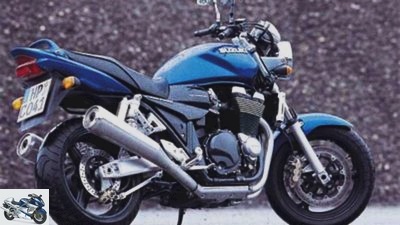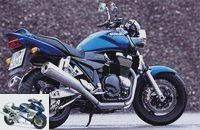Menus

Jahn
Top test Suzuki GSX 1400
The Maximus
He’s late but massive, Suzuki’s naked bike overhammer. The MOTORRAD top test clarifies whether the series four-cylinder with the largest displacement in the world, with a displacement of 1402 cubic centimeters, can do more than just handle torque.
Enough is not enough, thought the Suzuki strategists and sent their naked queen GSF 1200 Bandit, who is not exactly considered weak, a 1402 cm3 big brother to reinforce them. There is a lot of excitement in the area of the big four-cylinder Nackedeis. To show the gang around the Yamaha XJR 1300, Kawasaki ZRX 1200 and Co. where the hammer hangs, in Hamamatsu they didn’t just reach for the shelf, but rather sent the engineers to a retreat. Merely drilling out the tried and tested 1200 cm3 bandit perennial hit was not enough, they generously donated the designated head of displacement with a newly developed cylinder bank including a head – now with bucket tappets.
And the mighty pot has it all behind the classic-looking cooling fins, as it can show off with SACS, SDTV, SCEM, PAIR and a lot more. You only understand train station? So, one after the other: The mixture preparation of the air / oil-cooled (SACS) four-cylinder engine is carried out by an injection system with two separately controlled throttle valves (SDTV), 34 millimeters in diameter, arranged one behind the other. The four forged pistons then whiz up and down 68 millimeters in coated (SCEM) raceways – just like with the GSX-R models. Oh yes, although the bore and especially the stroke increased compared to the twelve hundred, the connecting rods and piston pins are lighter. To forget something? Exactly, PAIR stands for the secondary air system for exhaust gas cleaning. Catalyst? Nothing. Just like the choke, which could be deleted without replacement? electronic brownies come onto the scene during a cold start.
They do their job well: the Dickmann mumbles round and healthy after pressing the button. Vibrations are not an issue with the maximum displacement. Velvety soft and with a pleasant humming sound from the two chrome-plated mufflers, it rushes off. What a throttle response! Super soft responsiveness and relatively little play in the drive train are pleasing when exiting the underground car park as well as the subsequent ride on the motorway. Before full throttle is due, the 5.7 liters of engine oil must first be brought to temperature. Then it quickly becomes apparent that the wide belt of asphalt should only be used as a feeder for the real, curvy naked bike areas – although the Suzuki runs straight ahead without any problems and only has to admit defeat to the road resistance at 230 km / h. As is typical for naked bikes, the latter condition occurs much earlier for the pilot. Those who can endure longer in full throttle regions can apply as a washboard neck muscle model after a short time.
It is better to turn the throttle back a little and lace the track at a leisurely 130 km / h, in sixth gear the crankshaft then turns 4,000 times per minute, in the middle of the comfort range of the fourteen hundredth, trimmed to massive amounts of torque at relatively low speeds. As incredibly powerful as it starts from 1000 rpm, it is tough beyond the 7000 mark. Can be read from the range of torque that piles up from 2000 to beyond 6000 rpm ?? Peak 128 Newton meters – and the comparatively subtle peak power of 110 hp, which is already available at 7000 rpm. But who wants to be angry with the muscleman for that? In practice, staying in speed regions beyond 5000 rpm is seldom necessary anyway, especially since the tightly stepped six-speed box always offers the right connection and the sixth is sufficient for everything from local speed onwards, and the fifth is sufficient for everything from a local speed. The GSX 1400, which weighs 260 kilograms, dashes out into the country without jerking and jerking.
Clear goal: To swing around corners. To make it as fun as possible, the Suzuki calculators for the GSX 1400 forgot ?? In contrast to the Bandit – generously their red pencils and let posh spring elements through the controlling. For example, the fork, which is fully adjustable over a wide range, with massive 46 mm stanchions, and the two spring struts on the massive aluminum swing arm, which are reinforced with expansion tanks, which can be cleverly adjusted using handwheels and without tools. And they actually stand up to almost anything that gets in their way. Excellent balance, the spring elements take their horror away from even the worst wave slopes. So-called pitching occurs only on bumps in rapid succession, such as steps on concrete slab highways, in the tubular handlebars tightly packed in rubber mounts. Otherwise: No bottoming out, no soft swaying, the feedback about the road condition is always truthful and exact. The GSX chassis keeps suspension and damping reserves ready, even when riding with a pillion passenger. That’s a good thing, because a comfortable bench as well as appropriately arranged notches and solid holding options lure you to a longer two-person trip, which is not in the way of a sufficient load of 200 kilograms.
But back to the solo sprint: the five-hundredweight bolide always goes exactly where it should. And not just on a perfectly flat, well-developed roadway. Even if the paths become narrower and the curve radii tighter: the driving pleasure remains. To which the low tendency of the front Bridgestone BT020 to erect, the 190 tire at the rear, however, reacts sensitively to longitudinal grooves and similar distortions. Except for this blemish, the GSX is absolutely neutral and easy to handle, but reacts almost hyperactive when changing lean angles at lightning speed. But even wet, slippery bitumen connecting roads somewhere at the end of the world do not make the pilot’s hands sweaty. Only the powerful braking torque of the displacement giant should be taken into account. When the throttle grip is suddenly closed, the rear wheel can slip for a short moment on a smooth surface, as well as when the throttle is suddenly opened beyond the 3000 rpm mark.
On the other hand, the brakes intervene to build trust. The front six-piston Tokicos could be a bit more toxic from a sporting point of view, they look a bit furry when the lever is put on before they get down to business. In adverse conditions, however, this somewhat gentler interpretation is most welcome. The rear counterpart supports the front stoppers inconspicuously but effectively if necessary. And since the tightly damped fork shows no nakedness even in tough stopping maneuvers, the big Suzuki collects points in terms of negative acceleration.
Good things can also be said about the equipment: a classically designed cockpit that provides important information including the tank content and time, chrome and lots of polished aluminum are pleasing to the eye, solid prismatic chain tensioners and details such as a quick release in the fuel line for quick removal of the Tanks. Luggage hooks and a large storage compartment under the bench underline the touring qualities ?? which are only diminished by the rather high consumption. A generous 22 liter tank capacity enables a range of 333 kilometers on the country road despite a hefty 6.6 liters. It gets cheaper at a constant 100 km / h, then the Suzi sprays just under 5.4 liters per 100 kilometers through its double throttle valves.
VDriving eighteen hundred is just not cheap fun, which is also documented by the cost price of 19,000 marks. The motto “May it be a little more” applies to the GSX 1400 not only for displacement, chassis and workmanship, but also for the necessary budget. bigger is just better and not cheaper.
Buy complete article

Top test Suzuki GSX 1400
The Maximus
News & Facts
PlusBrake and clutch levers are adjustableSmooth acting clutchSpanner-friendly attached tank and attachmentsBattery easily accessible under the seatFully adjustable spring elements ?? rear even completely adjustable without toolsSix luggage hooks, spacious storage compartment and helmet lockSolid chain guard made of aluminumMirror with a good field of visionMinusField headlights only offer mediocre light outputJacking made more difficult due to an unfavorably arranged handleCock-like seat lockSlightly limited lean angleRear tires would react sensitively to longitudinal grooves and wheelballs Rings visible, rebound stage 6 clicks on, compression stage 3 clicks on shock absorber: spring base 1 (4) rings visible, rebound stage 2 (3), compression stage 3 (4) (values in brackets for sporty driving or pillion riding) Tires Front Bridgestone BT020F »F«, rear BT020R
Conclusion
Even if he is nonchalant when it comes to top performance, Suzuki’s high-torque four-cylinder displacement maximum is a stunner. Powerful and well-behaved, the – unfortunately quite thirsty – 1400 with its well–functioning chassis shows that it can do more than lift torque. For example, whiz through the landscape? also for two.
MOTORCYCLE readings – Suzuki GSX 1400
MOTORCYCLE measured valuesBraking and driving dynamicsBrake measurementsBraking distance from 100 km / h 37.9 m Average braking deceleration 10.2 m / s2 Comments: Slightly dull response behavior, good controllability and effect with higher manual force. Noticeable fading after the fourth emergency stop. Front wheel starts to stamp occasionally. Handling course I (tight arcs) Best lap time 29.2 secvmax at measuring point 49.3 km / h Comments: Good steering precision and very easy handling for this weight class. Noticeable tilting movements around the longitudinal axis when there are hard changes in load and inclination. Drives tight, even curve radii at the slow turning point without any special effort. Handling-Parcours II (wide arcs) Best lap time 20.4 secvmax at the measuring point 103.7 km / h Comments: Low steering forces and high steering precision due to the stable fork, but easy rocking and rocking around the longitudinal axis. Excellent measurement results for this motorcycle category. Keisbahn Ø 46 meters, lap time 11.4 secvmax at the measuring point 50.1 km / h Comments: Rest, side and main stands sometimes hit hard in left-hand bends. Good curve stability, only load changes act as disruptive impulses.
Related articles
-
Artist Top test Kawasaki ZZR 1400 The time machine Welcome in the future. The ZZR 1400 is said to be the first production bike in the world to shake 200…
-
Top test Suzuki SV 650 And the beat goes on Suzuki completely renovated its successful SV 650 model. The most important change: The lively twin received …
-
Comparison test touring enduro bikes: Honda Transalp, Kawasaki Versys, Suzuki V-Strom 650
Jahn comparison test travel enduro: Honda Transalp, Kawasaki Versys, Suzuki V-Strom 650 Always on the wall, travel enduro does not necessarily mean BMW …
-
Jahn comparison test Powercruiser Kawasaki VN 2000, Suzuki Intruder M 1800 R, Yamaha XV 1900 Midnight Star Punchtime Nobody distributes more displacement and …
-
Jahn Top test Suzuki B-King And yet so nice Suzuki’s B-King comes across as a real brutal bike, and looks like it is eating small children. Your promised…
-
Comparison test of supersports: Honda CBR 600 F, Kawasaki ZX-6R, Suzuki GSX-R 600, Yamaha YZF 600 R
Comparison test of super sports cars: Honda CBR 600 F, Kawasaki ZX-6R, Suzuki GSX-R 600, Yamaha YZF 600 R Let’s twist again Wake up, people. In the 600s …
-
Impression Suzuki VS 1400 Intruder
fact Impression Suzuki VS 1400 Intruder Big in Japan It was Suzuki’s big Intruder, which with 1360 cubic centimeters in the second half of the 80s as …
-
Johann Test Suzuki Bandit 650 ABS Bandit reissue An institution like the Suzuki Bandit 650 cannot be written off from a recently launched Yamaha XJ6….
-
Test, Suzuki VZ 800 Marauder Suzuki VZ 800 Marauder Keep doors and windows closed, protect your property: the marauders (looters) are on their way. D….
-
fact 5 photos Kawasaki 1/5 Kawasaki 2/5 Kawasaki 3/5 Kawasaki 4/5 Kawasaki 5/5 Top test Kawasaki 1400 GTR The Kawa-Über-Tourer Superlatives are a…